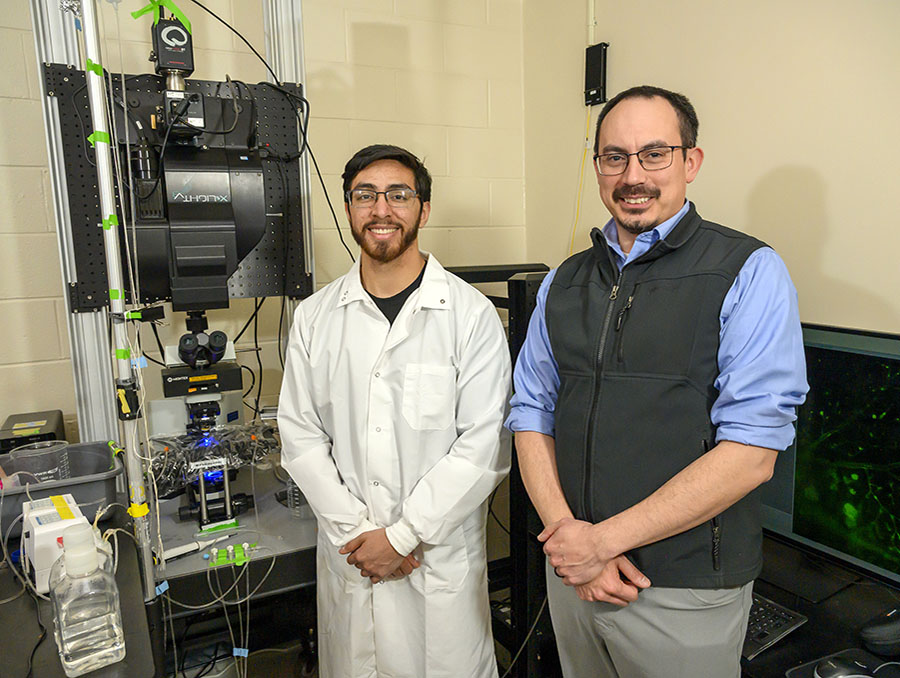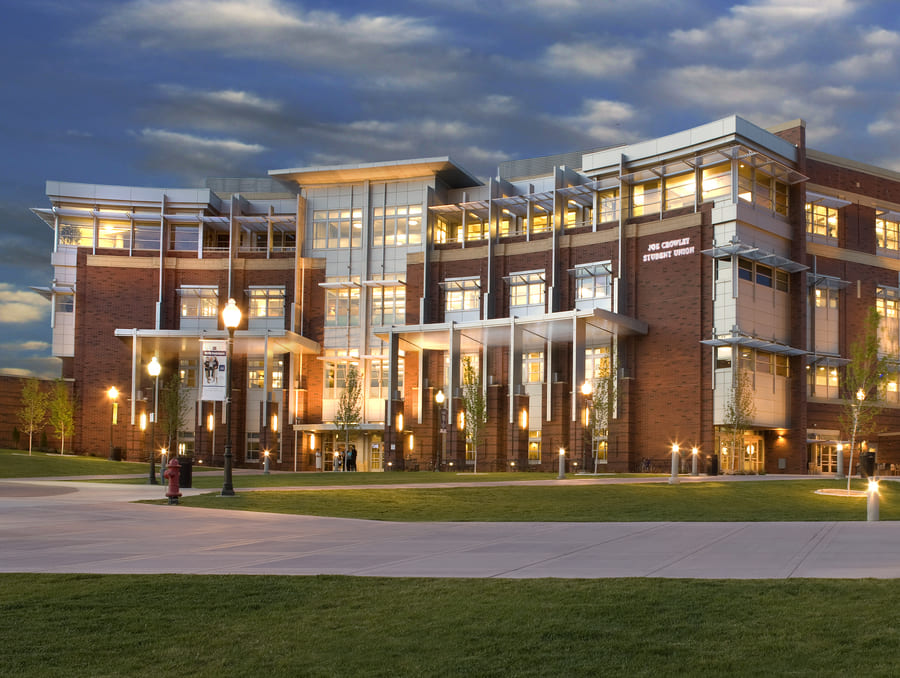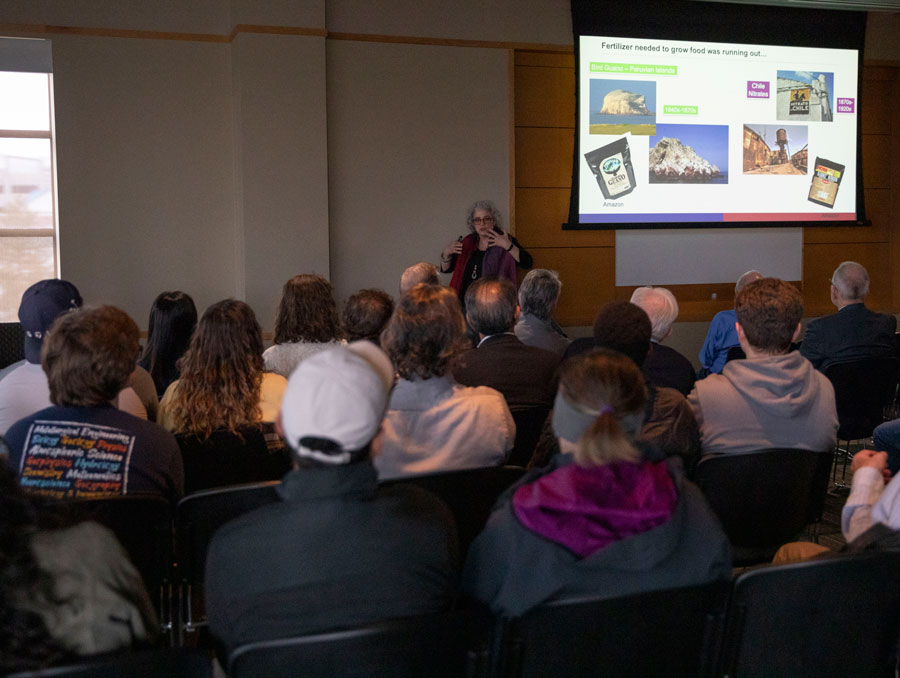When you sit quietly for a moment listening to your heart pump blood through your body, do you think about blood vessels as a firehose drenching your organs and brain with red blood cells full of oxygen and nutrients, or do you think about a series of carefully controlled spigots and valves turning on and off in a well-choreographed metabolic dance?
You don’t think of either? Well, Albert Gonzales, Ph.D., assistant professor of physiology and cell biology at the University of Nevada, Reno School of Medicine (UNR Med), does.
His research demonstrates that capillaries, the smallest branch of the circulatory system, play a significant role in deciding what parts of a tissue receives blood by using small control cells to regulate flow. Gonzales’ lab currently focuses on understanding the cellular and molecular mechanisms regulating blood flow entering the capillary microcirculation, according to the lab’s website.
 Cristian Franco, Ph.D candidate, demonstrates dissection of isolated retina using a dissection scope and pressure chamber.
Cristian Franco, Ph.D candidate, demonstrates dissection of isolated retina using a dissection scope and pressure chamber.“When you are watering a garden, you’re not just turning on the spigot full blast, that is wasteful,” he said as a metaphor for the human body’s circulatory system. “To make the process more efficient, you have to turn on a sprinkler or drip system to ensure each individual plant gets the appropriate amount of water.”
Air plants, for example, soak in water once every few weeks, while oak trees require a constant drip.
Gonzales’ garden metaphor aptly describes his hypothesis for how the body manages blood flow within various tissues, which questions the current scientific beliefs that blood flow is solely controlled by the spigot, or the larger blood vessels of the body, that when turned on equally delivers oxygen and nutrients to all cells all the time. But those models don’t make sense to Gonzales and his team.
“I argue each tissue has unique metabolic demands, and each one is unique in how it’s blood vessels are set up,” Gonzales said.
This is most notable in the brain. As you read this sentence, your entire brain isn’t flushed with blood all at once, but instead, the capillaries are capable of deciding which neurons are important for reading receive oxygen and nutrients depending on the need, he argues.
“The brain has neural circuits processing information and signals,” Gonzales said. “You have scenarios where two neighboring neurons, one actively engaged in conducting information and the other one not doing anything, will have different metabolic needs.”
He argues the body must use cells, called capillary pericytes, to manage the blood flow to meet the different demands of each neuron. With this, pericytes can make circulation more efficient by constricting or dilating to change which cells receive nutrients. In a garden, that would be a series of unique irrigation systems managed by a switch, timer or even a computer.
So, what is it in the body that fills that role?
 Albert Gonzales, Ph.D., left, and Cristian Franco, Ph.D. candidate, conduct imaging on a spinning disc confocalmicroscope to see retinal vasculature on a large monitor.
Albert Gonzales, Ph.D., left, and Cristian Franco, Ph.D. candidate, conduct imaging on a spinning disc confocalmicroscope to see retinal vasculature on a large monitor.Applying the science of blood flow
With a focus on basic science, Gonzales’ lab studies the why and how of human biology, health and disease. Basic science research includes biochemistry, microbiology, physiology and pharmacology. It involves conducting laboratory studies and helps inform other sciences and medicine, paving the way for new treatments and advances.
“At times, basic science can be a step ahead of clinical or therapeutic understanding because we’re discovering new cellular processes that may not be clinically relevant yet,” Gonzales said. “It gives clinicians foreshadowing for what to see in the next few years. The basic science discoveries can get accepted in the field, then translated to other systems and finally given a clinical approach. We can seed the ideas that will hopefully bear fruit in the next five to ten years.”
Better understanding and more knowledge can create medical interventions, pharmaceuticals or therapies. For example, one cause of Alzheimer’s disease is believed to be due to the accumulation of plaque, or cellular waste, that disrupts the ability for the brain to function. Gonzales hypothesizes that loss of blood flow “efficiency” can cause a runaway effect in people.
“As you lose pericytes, the efficiency of blood flow delivery decreases, and over time, as it worsens, it can snowball to the point of the disease,” he said. “The vasculature is no longer serving its purpose of delivering oxygen and nutrients, and removing waste. Blood is no longer going to the furthest reaches of the capillary network, and then those neurons are in trouble.”
His lab is trying to parse out why pericytes breakdown in this disease. If his team can determine what causes the pericytes and capillaries to stop doing their job, there may be applications in the future for changing how Alzheimer’s and similar neurological diseases progress within the brain.
The lab is working on a grant from the National Institutes of Health to support this hypothesis. In a similar vein, Gonzales’ team is also working on applying this science to macular degeneration research with grant funding from the Bright Focus Foundation. Macular degeneration is caused by accumulating waste products within the back of the eye that won’t flush away. The team wants to determine if light directly affects blood vessels and how it might change the removal of waste product in people with macular degeneration.
“We’re looking at this intrinsic ability of the blood vessels to respond to light and how it changes the fluid dynamics within the eye,” Gonzales said. “This hasn’t been seen before.”
Gonzales is optimistic about the current speed of discovery and innovation. What would’ve taken decades before has been condensed to faster timelines.
“With more people, effort and scientific capabilities, we can push for discoveries faster, with hopes that the best ideas rise to the top,” he said. “A lot of things can slow down science, but when there’s a need, science can push through, and when there’s a team effort, we can push science farther.”















